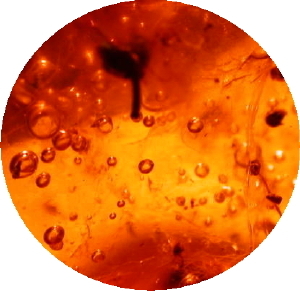The Pre-flood Atmosphere
 There is evidence that the atmosphere enveloping the early earth was very different than it is today. It seems that at one time the entire earth enjoyed a warm tropical environment and there was enhanced oxygen in the atmosphere. Organisms would have grown larger than their modern counterparts and could also have lived longer. For example, massive fossilized trees in the Florissant Fossil Beds National Monument of Colorado appear to be much older than their tree rings would indicate they actually were (Oard, Michael, “The Florissant Redwood Trees Deposited from a Flood Log Mat,” Journal of Creation, 2019, p. 91.)
There is evidence that the atmosphere enveloping the early earth was very different than it is today. It seems that at one time the entire earth enjoyed a warm tropical environment and there was enhanced oxygen in the atmosphere. Organisms would have grown larger than their modern counterparts and could also have lived longer. For example, massive fossilized trees in the Florissant Fossil Beds National Monument of Colorado appear to be much older than their tree rings would indicate they actually were (Oard, Michael, “The Florissant Redwood Trees Deposited from a Flood Log Mat,” Journal of Creation, 2019, p. 91.)
Many creationists have attributed this special primeval atmosphere to a water vapor canopy that was created by God on the second day, the “waters above the firmament” (Genesis 1:7). This theory holds that a “vast blanket of invisible water vapor, translucent to the light of the stars but productive of a marvelous greenhouse effect which maintained mild temperatures from pole to pole, thus preventing air-mass circulation and the resultant rainfall (Genesis 2:5). It would certainly have had the further effect of efficiently filtering harmful radiation from space, markedly reducing the rate of somatic mutations in living cells, and, as a consequence, drastically decreasing the rate of aging and death.” (Morris, Henry, Scientific Creationism, 1984, p. 211.) Citing evidence of denser atmosphere in the past, Morris postulated that this vapor layer could have dramatically increased the atmospheric pressure on the surface of the early earth, again contributing to a healthier environment (like a natural hyperbaric chamber). Later the canopy would have collapsed in the form of rain (the “windows of heaven” in Genesis 7:11), contributing to the Flood water, and resulting in the dramatic drop-off in longevity after the deluge.
 Genesis 9 tells the story of how Noah planted a vineyard after the flood. He then became drunk from the fruit of it and lay in a stupor within his tent. This event is an aberration in the life of this godly man. Could it be that Noah was caught by surprise by how quickly he became inebriated? It seems that drinking at high altitude can lead to people becoming intoxicated more quickly. Perhaps living on the mountainous slopes of Ararat and breathing from the reduced post-Flood air pressure contributed to this situation, making it harder for Noah to “hold his drink.” While this is only speculation, the removal of the vapor canopy certainly could help explain this curious situation.
Genesis 9 tells the story of how Noah planted a vineyard after the flood. He then became drunk from the fruit of it and lay in a stupor within his tent. This event is an aberration in the life of this godly man. Could it be that Noah was caught by surprise by how quickly he became inebriated? It seems that drinking at high altitude can lead to people becoming intoxicated more quickly. Perhaps living on the mountainous slopes of Ararat and breathing from the reduced post-Flood air pressure contributed to this situation, making it harder for Noah to “hold his drink.” While this is only speculation, the removal of the vapor canopy certainly could help explain this curious situation.
Some creationists emphasize other factors that may have caused the worldwide temperate conditions that existed before the Flood. They stress the evidence of far greater concentrations of carbon dioxide levels in the past and point out that the earth’s magnetic field was far stronger than today. This could have acted as the shield for cosmic radiation and produced the healthier environment. (Humphreys, Russel D., Starlight and Time, 1995, p. 63.) Creationist John Baumgardner suggested that the atmosphere surrounding the original earth was far thicker than it is today and that the exploding of the fountains of the great deep during the initial stages of the Genesis Flood stripped some of that original atmosphere away. Certain Bible scholars cite the language of the Psalm 148:4 as evidence against a vapor canopy. If the canopy had collapsed during the flood, they reason, why does the Psalmist still reference the waters above the firmament? But this poetic allusion could hark back to the original creation, or it could refer to some of the original water vapor (left over from the canopy) still in the outer reaches of our atmosphere. Computer modeling of a vapor canopy have shown that it is extremely effective as a thermal blanket, causing global warming. In fact, a canopy of significant size would result in extreme temperatures on Earth. This is a matter of ongoing creationist climate research.
For those Christians who doubt the pre-Flood existence of a water vapor canopy, the question remains: what exactly did God do on Day 2 of creation? Genesis Park concurs with creationist James D. Johansen when he states: “Day 2 creation focuses on the habitability of Earth and the basis for the Earth’s expanse that exists with the numerous properties required to support an abundant biological life. First, it is implied that water was created on Day 1 so it can be manipulated where it is located. An atmosphere is created. Second, water is moved to subterranean locations that can be called upon to support plant and animal life. Third, some water is transformed into water vapor and resides in the upper atmosphere, acting as a shield for Earth’s expanse. Water is transparent in the human spectrum, so seeing the space expanse is still available.” (Johansen, James D., “Human Brain Function Above All Other and the Creation Model,” Proceedings of the Ninth International Conference on Creationism, 2023, p. 293.)
It is interesting that scientists who would not subscribe to the water vapor canopy theory described above, have published articles that lend credence to portions of that theory. “Using evidence collected in South America and New Zealand, an international team of researchers has determined that climate changes – both warming and cooling patterns – during the late Pleistocene occurred rapidly and were global in scale. As giant iceberg armadas flooded the North Atlantic, alpine glaciers were simultaneously advancing across the Chilean Andes and Southern Alps of New Zealand. Thomas Lowell, associate professor of geology at the University of Cincinnati, and his colleagues published their findings in the September 15, 1995, issues of Science. …So, what did cause the climate changes? Lowell admits that he and his colleagues have no quick and easy answers. Possibly water vapors played a role. ‘A lot of water vapor in the atmosphere leads to a warmer climate,’ he states. ‘If there’s less vapor, temperatures become colder. Amounts of water vapor can change quickly, and the geological record indicates that climate changes could be very fast.'” (Anonymous, “Were Climate Changes Global During Ice Ages,” Geotimes,vol. 41, 1996, p.7, as cited in Morris, 1997, p. 305.) Additionally some scientists have been quite surprised to find water vapor in the freezing atmospheres of Jupiter, Uranus, Neptune and Saturn. (Dayton Daily News, April 8, 1998, p. 12A)
The water vapor canopy hypothesis would neatly explain yet another observed anomaly…too much water in Earth’s upper atmosphere. NASA satellites have confirmed far more hydroxyl in the hydrosphere than current models predict. The parent molecule of hydroxyl (OH) is water (H2O). Because ultraviolet radiation from the sun breaks down water in Earth’s upper atmosphere into hydroxyl and hydrogen, a large amount of water must have previously existed. Some have proposed a constant influx of mini-comets as a source for the mysterious water, but that theory has been strongly criticized as unworkable. (Matthews, Robert, New Scientist, July, 1997, pp. 26-27.)
 It seems that another interesting feature of the early earth atmosphere was enhanced oxygen. Microscopic air bubbles trapped in fossilized tree resin were analyzed by Robert Berner of Yale and Gary Landis of the U.S. Geological Survey. The “gas bubbles enclosed in fossil amber may represent ancient air trapped at the time the original resin was exuded from its host tree” thus providing a glimpse into the ancient past (Berner, Landis, “Analysis of Gases in Fossil Amber, American Journal of Science 318:5, 2018, pp. 590-601.) The procedure involved clamping an amber sample “into a vacuum chamber of a quadrupole mass spectrometer, a device that identifies the chemical composition of a substance. As the machine slowly crushed the sample, the microscopic bubbles were released, exhaling up to 100 billion molecules. These breaths disclosed some surprising evidence: the ancient air contained 50 percent more oxygen than the air today.” Landis believes that the subsequent reduction in oxygen could have led to the dinosaur’s demise. (Discover, February, 1988, p. 12.)
It seems that another interesting feature of the early earth atmosphere was enhanced oxygen. Microscopic air bubbles trapped in fossilized tree resin were analyzed by Robert Berner of Yale and Gary Landis of the U.S. Geological Survey. The “gas bubbles enclosed in fossil amber may represent ancient air trapped at the time the original resin was exuded from its host tree” thus providing a glimpse into the ancient past (Berner, Landis, “Analysis of Gases in Fossil Amber, American Journal of Science 318:5, 2018, pp. 590-601.) The procedure involved clamping an amber sample “into a vacuum chamber of a quadrupole mass spectrometer, a device that identifies the chemical composition of a substance. As the machine slowly crushed the sample, the microscopic bubbles were released, exhaling up to 100 billion molecules. These breaths disclosed some surprising evidence: the ancient air contained 50 percent more oxygen than the air today.” Landis believes that the subsequent reduction in oxygen could have led to the dinosaur’s demise. (Discover, February, 1988, p. 12.)
 Other studies of air bubbles in amber have found increased pressure as well as the greater oxygen levels. “One implication is that the atmospheric pressure of the Earth would have been much greater during the Cretaceous era, when the bubbles formed in the resin. A dense atmosphere could also explain how the ungainly pterosaur, with its stubby body and wing span of up to 11 meters, could have stayed airborne, he said. The spread of angiosperms, flowering plants, during the Cretaceous era could have caused the high oxygen levels reported by Berner and Landis, scientists said last week.” (Anderson, Ian, “Dinosaurs Breathed Air Rich in Oxygen,” New Scientist, vol. 116, 5 November 1987, No. 1585, p. 25.) A Yale study published in the March 3, 2000 issue of Science independently confirmed the high levels of oxygen present in the earth’s distant past. Some have even suggested that without such an atmosphere the relatively small lung capacity in certain dinosaurs could not have supplied their massive tissue with the needed oxygen.
Other studies of air bubbles in amber have found increased pressure as well as the greater oxygen levels. “One implication is that the atmospheric pressure of the Earth would have been much greater during the Cretaceous era, when the bubbles formed in the resin. A dense atmosphere could also explain how the ungainly pterosaur, with its stubby body and wing span of up to 11 meters, could have stayed airborne, he said. The spread of angiosperms, flowering plants, during the Cretaceous era could have caused the high oxygen levels reported by Berner and Landis, scientists said last week.” (Anderson, Ian, “Dinosaurs Breathed Air Rich in Oxygen,” New Scientist, vol. 116, 5 November 1987, No. 1585, p. 25.) A Yale study published in the March 3, 2000 issue of Science independently confirmed the high levels of oxygen present in the earth’s distant past. Some have even suggested that without such an atmosphere the relatively small lung capacity in certain dinosaurs could not have supplied their massive tissue with the needed oxygen.
In October 2006 Science Daily publicized a study led by Arizona State University staff entitled “Giant Insects Might Reign If Only There Was More Oxygen In The Air.” The article claims, “The delicate lady bug in your garden could be frighteningly large if only there was a greater concentration of oxygen in the air, a new study concludes. The study adds support to the theory that some insects were much larger during the late Paleozoic period because they had a much richer oxygen supply, said the study’s lead author Alexander Kaiser. The Paleozoic period…was a time of huge and abundant plant life and rather large insects — dragonflies had two-and-a-half-foot wing spans, for example. The air’s oxygen content was 35% during this period, compared to the 21% we breathe now, Kaiser said.” This research concurs with the biblical model of the early earth. In 2010 researchers at Arizona State University presented the results of experiments raising insects in various levels of atmospheric oxygen. Ten out of twelve varieties of insects studied decreased in size with lower oxygen. Some, like dragonflies, grew faster and became bigger in an enriched oxygen atmosphere (Science Daily, October 30, 2010.).
Some object strongly to using the scriptures to gain scientific insight into the natural world. While the Bible is not a science text, there are several clear lines of evidence that the Bible is God’s Word. If God’s word is truly inspired, it speaks accurately to all areas of knowledge: historical, political/economic, sociological, and scientific.
